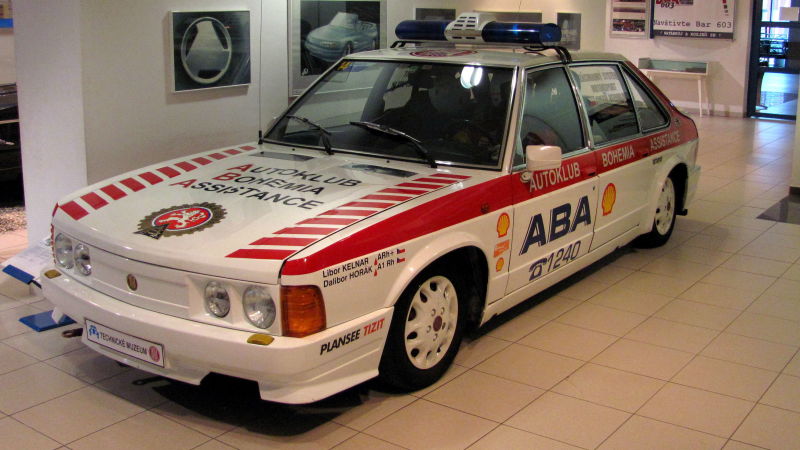
This weekend, Lewis Hamilton, Max Verstappen and the rest of their pals will battle it out on the Hungaroring in the 2019 Hungarian Grand Prix. Should something unfortunate happen requiring one of them (or one of the other drivers that are allegedly also competing in this race) to receive emergency medical attention, a Mercedes-AMG E63 Wagon will rush out to the track and use all 603 of its horsepower to get the doctor to the driver as soon as humanly possible.
But back when the Hungarian Grand Prix was first started back in 1986, the communist big wigs weren’t about to let anything German and over-powered across the Iron Curtain. But they did let Bernie Ecclestone and Formula One in, and to play the part of the safety car at the time, they chose the best thing they had. They chose a Tatra.
In the event that Alain Prost, Ayrton Senna, Nelson Piquet, or Nigel Mansell found themselves in need of immediate care, the Tatra T623 Special Rapid Response Vehicle would probably be first on the scene, air-cooled V8 screaming away.
Fortunately that first race went off largely without a hitch but if they needed it, though, the T623 was ready.
Advertisement

The T623 was conceived by Cyril Svoboda, a former race car driver and emergency rescue pioneer known for building his first response vehicle out of a Lancia Beta. Not satisfied with the space or power available in his Italian coupe, Svoboda knew that the car he needed was closer to home.
Advertisement
He needed a Tatra, but, not being a member of the Politburo, it wasn’t simple for Cyril to get his hands on one.
Cyril and his motoring rescue organization NAREX (now NARIMEX) developed the T623 from the “standard” T613 limousine used to ferry around communist party officials and other members of the ruling class. In the Eastern Bloc, there weren’t many choices for cars that could perform above the bare minimum, so Cyril didn’t have a ton of choice.
Advertisement
Still, the big V8-powered four-door, with its engine in the back, made for a surprisingly practical platform for getting out onto the track and keeping up with race cars. It also didn’t hurt that the bodywork was designed by Vignale.

Advertisement
In its original guise, the T623 S featured the same standard 3.0-liter air-cooled V8 as the T613 road car, but other improvements like a 30mm drop to ride height, lightened body panels, plexiglass windows significantly improved performance.

Advertisement
As the car became a regular feature at motorsports events in the Czech Republic, attention grew and emergency first-responders like firefighters started to express interest in the model and, according to this article that I expertly ran through Google Translate, it was eventually certified as an official model in its own right even though they were largely built from used T613s after their service life as state cars.

Advertisement
Though the T623 was built by an outside organization, Tatra was no stranger to building special versions of its already unique cars. Bucking the norms that had come to dictate the bulk of automotive engineering, Tatra stubbornly stuck to its air-cooled, rear-engined shape.
Though this did result in some unique packaging challenges (many early Tatras didn’t have a rear window), eventually Tatra’s engineers figured out how to turn the earlier T603 and T613 into a number of unique vehicles for special purposes, including for racing.
Advertisement
By the time that NAREX was invited to supply the safety car for that first Grand Prix in 1986, Svoboda had already refined his original T623 S, replacing the earlier 3 liter engine with a larger 3.8-liter V8 making more than 300 horsepower. This new car was designed to keep up with F1 cars as recent safety regulations introduced by Sid Watkins mandated that a safety car follow the cars through the first, most dangerous lap.
Advertisement
Further lightened and enhanced with safety features like a quick-remove steering wheel, the new car was capable of reaching speeds in excess of 186 miles per hour and received a new name: The Tatra T623-R.
Advertisement
The new car would serve as the official safety car at all F1 races at the Hungaroring for nearly 10 years. Its final year of service, 1995, would be marred by an incident in which driver Taki Inoue was struck by a marshal driving a T623-R while assisting others to extinguish a fire in another car.
In the next season safety cars would be standardized by the FIA, putting the Tatras out to pasture in official capacity. That wouldn’t be the end of the line for the end of the line for Tatra emergency vehicles.
Advertisement
While Tatra no longer builds cars, its all-terrain trucks have become well-known for fighting forest fires, and as airport crash trucks. One can only assume that the experience gained in F1 continues to be put to good work.















